NIR (near-infrared) light therapy can effectively improve your poor blood flow through several key mechanisms. When you expose your body to NIR wavelengths between 800-2,500 nm, it triggers the release of nitric oxide, causing your blood vessels to dilate and circulation to increase. You'll experience enhanced oxygen delivery and nutrient transport to your tissues, while waste removal improves through expanded lymphatic vessels. The therapy also reduces inflammation and promotes healing by activating cellular repair processes. Within 10-20 minutes of treatment, you can notice increased blood flow that lasts for several hours. Understanding the full treatment protocol will help maximize your circulatory benefits.
What Is NIR Light Therapy
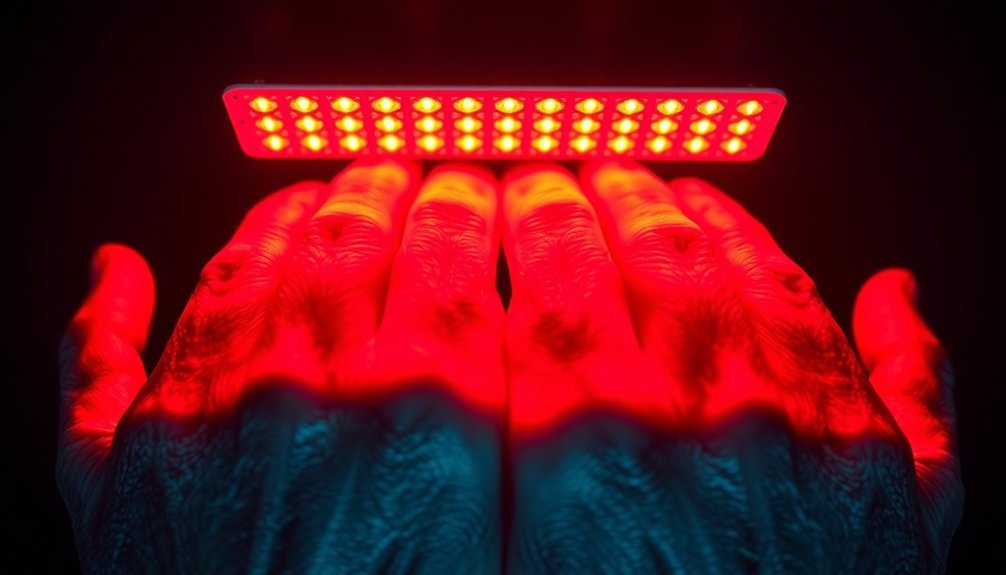
A groundbreaking advancement in medical technology, NIR light therapy (or photobiomodulation) uses specific wavelengths of near-infrared light between 800-2,500 nm to promote healing throughout your body. This non-invasive treatment penetrates deep into your skin layers, activating a series of beneficial physiological responses that can transform your health.
When you undergo NIR light therapy, it stimulates special molecules called chromophores in your cells. These chromophores absorb the light and trigger a cascade of biological processes that enhance your body's natural healing abilities. Recent technological advances have made home-use devices increasingly available for convenient treatment without direct supervision.
The therapy primarily works by energizing your mitochondria – the powerhouses of your cells – which leads to improved cellular regeneration and energy production.
You'll find NIR light therapy particularly effective because it can reach your brain tissue through an optical window between 650-1,200 nm without generating excessive heat. This allows the treatment to initiate both short- and long-term positive effects in your body, including enhanced blood flow, reduced inflammation, and improved tissue repair.
It's proven safe and effective for various conditions, from healing wounds to treating neurological disorders, making it a versatile option for maintaining your health.
Common Blood Flow Problems
Your body sends clear warning signs when blood flow problems develop, including numbness in your hands and feet, cold extremities, and ongoing fatigue.
These symptoms often point to peripheral artery disease, a condition where narrowed blood vessels restrict circulation to your limbs. High blood pressure can make blood vessels less elastic and worsen circulation problems over time.
If you're experiencing persistent tingling sensations, skin discoloration, or slow-healing wounds, you'll need to take these signs seriously as they indicate potentially serious circulatory issues that require attention.
Circulatory System Warning Signs
Recognizing poor blood flow early can prevent serious health complications down the road. Your body sends clear warning signals when circulation isn't at its best, and you'll want to pay attention to these important indicators.
If you're experiencing numbness, tingling, or throbbing pain in your limbs, along with frequent muscle cramps, it's time to take action. Many people experience persistent fatigue issues when circulation problems develop.
Visual signs can be equally telling – watch for changes like hair loss on your feet and legs, dry or cracked skin on your extremities, and bluish tints in your nail beds. You might also notice varicose veins developing near your feet and ankles.
Here are three serious systemic effects you shouldn't ignore:
- Wounds that heal slowly due to poor nutrient delivery
- Dizziness when standing up, indicating blood pressure irregularities
- Cognitive function issues from reduced brain blood flow
Your risk increases substantially if you have underlying conditions like diabetes or heart problems. A sedentary lifestyle, smoking, and obesity can worsen circulation issues.
Don't wait until these symptoms become severe – addressing poor circulation early helps prevent complications like heart attacks and strokes.
Peripheral Artery Disease Symptoms
While many circulatory issues can affect blood flow, peripheral artery disease (PAD) stands out as one of the most serious conditions affecting millions of Americans. If you're experiencing pain in your legs while walking that goes away after resting, you might be dealing with PAD's most common symptom: intermittent claudication. This condition typically affects your hips, thighs, or calves during physical activity. PAD affects an estimated 10 to 14 million Americans, impacting men and women at equal rates.
| PAD Symptom | What You'll Notice |
|---|---|
| Pain Pattern | Cramping during activity that subsides within 5-10 minutes of rest |
| Temperature Changes | Cold sensation in lower legs and feet |
| Skin Appearance | Pale when legs are raised, reddish when sitting |
| Sensation Issues | Numbness or tingling in affected areas |
| Physical Changes | Loss of hair around ankles |
You'll want to pay close attention to these symptoms because PAD is often progressive and can worsen if left untreated. The condition results from plaque buildup in your arteries, reducing blood flow to your limbs. It's particularly common if you're over 65, have diabetes, smoke, or struggle with high blood pressure. Since PAD increases your risk of heart attack and stroke, it's vital to recognize these symptoms early and seek medical attention.
How NIR Improves Circulation
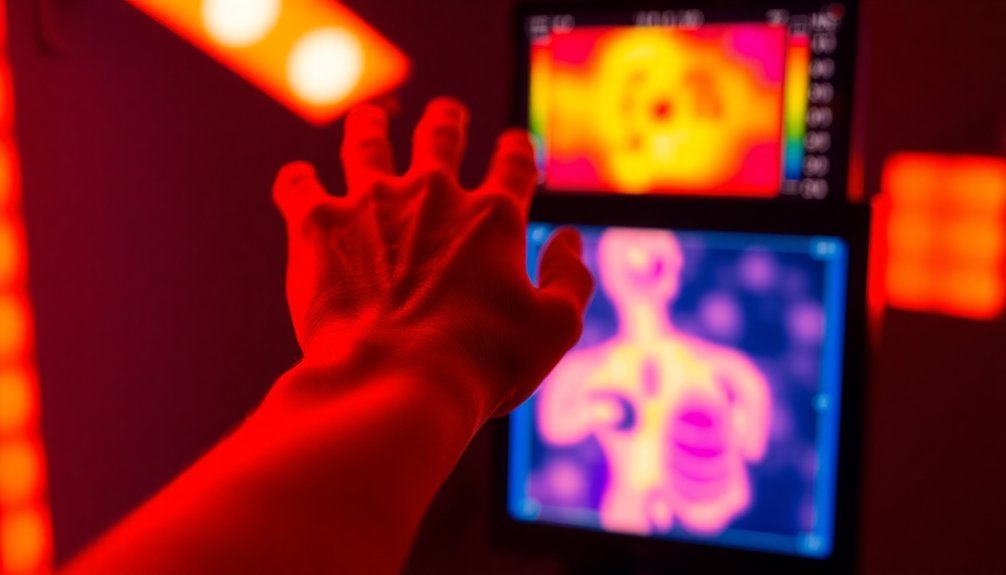
NIR therapy works by triggering your blood vessels to widen through the release of nitric oxide, allowing more blood to flow through previously constricted areas.
The enhanced blood flow reaches deep into your tissues, delivering essential oxygen and nutrients while removing waste products more efficiently.
You'll experience improved circulation throughout the treated area as NIR light penetrates beneath your skin to stimulate blood movement at multiple tissue depths.
NIR Triggers Vessel Dilation
Light therapy consistently triggers a crucial mechanism for improving circulation – the release of nitric oxide (NO) from cellular storage. When NIR wavelengths penetrate your tissues, they stimulate the release of NO from specific proteins and compounds called S-nitrosothiols.
This released NO then acts as a powerful vasodilator, causing your blood vessels to expand and allow more blood flow.
The vasodilation process is particularly effective because it works through your body's natural mechanisms. When NIR light hits your blood vessels, it triggers an endothelium-dependent response, meaning the inner lining of your vessels actively participates in the dilation process.
Here's how NIR-triggered vasodilation benefits your circulation:
- Your arteries and small blood vessels expand, allowing more blood to flow through previously constricted areas
- The increased vessel diameter leads to better oxygen delivery and nutrient transport to your tissues
- Your lymphatic vessels also dilate, improving waste removal and immune system function
This therapeutic effect isn't short-lived – studies show that NIR light can create sustained vasodilation, particularly in major vessels like the occipital arteries, helping maintain improved blood flow over time.
Deeper Tissue Blood Movement
Beyond the surface-level vasodilation effects, deep tissue circulation benefits from NIR therapy through multiple cellular mechanisms. When NIR light penetrates your tissues, it stimulates your mitochondria to produce more ATP, energizing cells and accelerating their repair processes. This enhanced cellular activity directly improves blood movement through your deeper tissues.
NIR therapy's impact on deep circulation doesn't stop there. It triggers the production of nitric oxide, which relaxes your blood vessels and creates better pathways for blood flow. This improvement extends to your smallest blood vessels, enhancing microcirculation throughout your body's tissues.
You'll also experience reduced inflammation, which allows blood to move more freely through previously restricted areas.
What's particularly remarkable is NIR's ability to stimulate angiogenesis – the formation of new blood vessels. This process creates additional pathways for blood flow, especially in areas where circulation has been compromised. As these new vessels develop, they work alongside your existing vasculature to deliver oxygen and nutrients more effectively to your deeper tissues.
The combined effect of these mechanisms means you're not just improving surface blood flow – you're enhancing circulation at every tissue level.
Medical Benefits of NIR Therapy
Four major areas highlight the transformative medical benefits of NIR therapy: cardiovascular health, pain management, immune function, and anti-aging effects.
When you undergo NIR therapy, you'll experience improved vascular function and enhanced blood flow throughout your body. The treatment increases nitric oxide production and decreases vascular resistance, leading to better overall circulation.
Your pain and inflammation will decrease as NIR penetrates deep into your tissues, stimulating cellular energy metabolism and promoting faster healing. You'll notice enhanced immune function through increased white blood cell production and improved detoxification processes.
- Your cardiovascular system benefits from reduced cardiac load and improved blood vessel health
- Your muscles and joints experience accelerated healing through enhanced cellular repair mechanisms
- Your immune system becomes stronger while your body's natural detoxification processes improve
The anti-aging effects are particularly significant, as NIR therapy stimulates cell regeneration and reduces body fat. You'll experience improved flexibility, reduced joint pain, and rejuvenated skin health.
The therapy's ability to recharge mitochondria and boost metabolism contributes to these regenerative benefits, making it an extensive treatment for overall wellness.
NIR Treatment Protocol
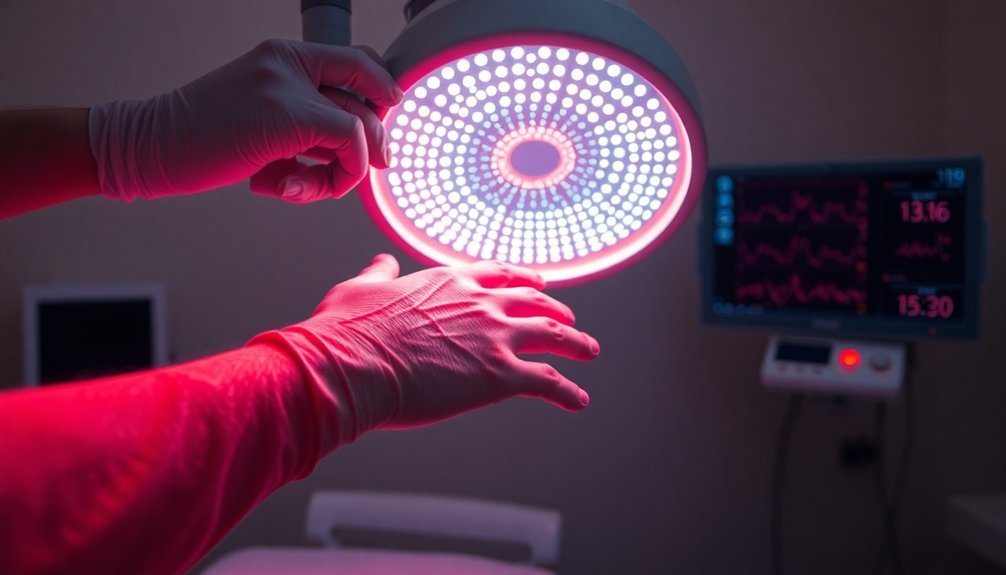
Starting a successful NIR therapy protocol requires attention to specific treatment parameters and proper device selection. You'll need to choose a high-quality device from a reputable manufacturer and follow specific guidelines for the best results.
Treatment sessions typically range from a few minutes to 20 minutes, depending on your device's intensity and the area being treated.
For effective treatment, you'll need to maintain consistency in your sessions. Treatment frequency can vary from daily applications to several sessions per week, using specific wavelengths like 750 nm and 950 nm. You'll also need to think about pulse rates, which can include 73 Hz, 587 Hz, or 1175 Hz, depending on your treatment goals.
Position your device either in direct contact with your skin or at the manufacturer's recommended distance. Your treatment protocol might involve three sessions per week for six weeks, though this can vary based on your condition.
If you're using NIR therapy for post-surgery recovery or treating musculoskeletal injuries, you'll want to follow a healthcare professional's recommended protocol. Remember to standardize your treatment parameters to achieve consistent results, and always consult with a healthcare provider before starting your NIR therapy regimen.
Nitric Oxide Release Process
Near-infrared light triggers your endothelial cells to produce nitric oxide, which acts as a powerful signaling molecule in your blood vessels.
When released, nitric oxide binds to the heme region of guanylyl cyclase in your vascular smooth muscle cells, initiating a cascade of reactions that cause these muscles to relax.
Your blood vessels then expand, allowing for increased blood flow and improved circulation throughout the treated area.
Vasodilation Activation Pathway
Blood vessels maintain their essential flexibility through a fascinating molecular dance involving nitric oxide (NO). When your endothelial cells produce NO from L-arginine and oxygen, it sets off a precise chain of events that directly impacts your blood flow. This process relies on endothelial nitric oxide synthase (eNOS), which requires calcium-calmodulin and specific cofactors to function properly.
The vasodilation pathway follows these critical steps:
- NO freely diffuses across cell membranes and enters vascular smooth muscle cells, where it activates an enzyme called guanylyl cyclase
- This activation triggers the production of cyclic guanosine monophosphate (cGMP), which then stimulates protein kinase G (PKG)
- PKG reduces intracellular calcium levels, leading to smooth muscle relaxation and blood vessel widening
Your blood vessels respond to various stimuli that can enhance this process. Shear stress, acetylcholine, and certain cytokines all stimulate eNOS activity, increasing NO production.
Additionally, hydrogen sulfide can boost eNOS function through S-sulfhydration and by increasing the availability of necessary cofactors, fine-tuning your vascular tone for ideal blood flow.
Endothelial Cell Response
Your body's endothelial cell machinery springs into action through a complex NO release process that responds to multiple triggers. When your endothelial cells detect stimuli like shear stress, platelet-derived factors, or acetylcholine, they activate endothelial nitric oxide synthase (eNOS) to begin NO production.
The process requires calcium-calmodulin and specific cofactors to convert L-arginine into nitric oxide. Your eNOS oxidizes L-arginine's guanidine group, consuming five electrons and producing L-citrulline as a byproduct.
When you're exposed to NIR light therapy, it enhances this cellular response, particularly under low-oxygen conditions.
Your endothelial cells don't just produce NO; they become metabolically more active when exposed to light irradiation. This increased activity triggers a cascade of responses, including extracellular calcium influx and enhanced VEGF production.
In hypoxic conditions, your endothelial cells work even harder, ramping up NO generation to promote vasodilation and improve blood flow. The NO they produce plays a vital role in helping blood vessels dilate and ensuring proper oxygen delivery to your tissues through its interaction with hemoglobin.
Blood Vessel Expansion Process
Understanding how blood vessels expand begins with the remarkable nitric oxide (NO) release process. Your body produces NO through endothelial nitric oxide synthase (eNOS), which converts L-arginine and oxygen into this powerful vasodilator.
When factors like shear stress and acetylcholine stimulate eNOS, it triggers a chain reaction that'll help your blood vessels relax and expand.
The expansion process works through three key mechanisms:
- NO activates the cyclic guanosine monophosphate (cGMP) pathway in your smooth muscle cells, causing them to relax and dilate your blood vessels.
- Your red blood cells transport and release NO strategically to guarantee oxygen reaches tissues that need it most.
- NO prevents platelets from clumping together and stops white blood cells from sticking to vessel walls, maintaining smooth blood flow.
You'll find this process particularly important for blood flow autoregulation in your smaller vessels. When it's working properly, NO helps control your blood pressure and guarantees adequate oxygen delivery to your tissues.
If you're experiencing poor blood flow, treatments using NO donors like nitroprusside can effectively improve your circulation without significant side effects.
Blood Flow Recovery Time
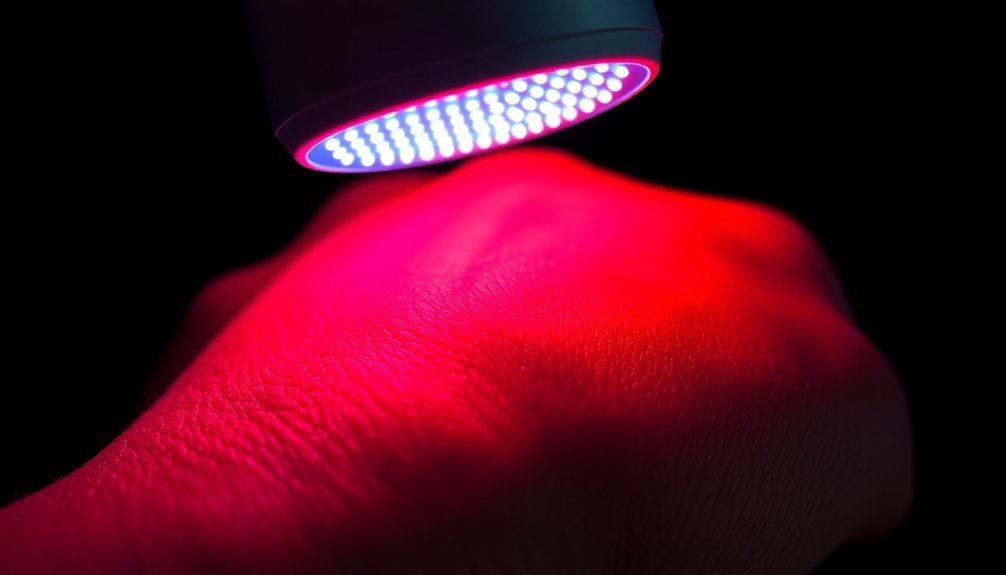
Most people can experience noticeable blood flow improvements within 10-20 minutes of starting NIR therapy treatment. Your blood vessels will dilate as nitric oxide is released, immediately enhancing circulation to targeted areas. This quick response means you'll feel the effects, such as reduced muscle tension and improved oxygen delivery, during your first session.
You'll need consistent treatment to maintain and maximize these benefits. Plan for 3-4 sessions per week, with each session lasting 10-20 minutes for peak blood flow improvement.
If you're dealing with injuries or specific conditions, you might benefit from daily sessions lasting up to 30 minutes. Your recovery timeline will depend on your condition's severity and treatment consistency.
The improved blood flow will help clear metabolic waste products like lactic acid from your muscles, reducing fatigue and soreness. You'll notice faster muscle recovery and reduced inflammation, especially if you're dealing with DOMS or soft tissue injuries.
Your cells will produce more ATP as mitochondrial activity increases, enhancing your overall healing process. For conditions like peripheral neuropathy or diabetic neuropathy, you may need ongoing treatments to maintain improved circulation and manage symptoms effectively.
Combining NIR With Other Therapies
NIR therapy works exceptionally well when combined with other treatments to enhance their effectiveness. When you combine NIR light therapy with various medical treatments, you'll experience enhanced therapeutic outcomes, particularly in improving blood flow and vascular function.
NIR light's ability to penetrate deep into tissues while carrying minimal toxicity makes it an ideal companion to other therapeutic approaches.
Here are three powerful ways NIR therapy enhances other treatments:
- Increases drug delivery effectiveness by improving vascular permeability and blood flow, allowing medications to reach their targets more efficiently.
- Enhances photobiomodulation therapy (PBMT) results by stimulating nitric oxide production and boosting peripheral blood circulation.
- Amplifies low-level laser therapy (LLLT) benefits through improved blood vessel function and increased venous blood flow.
The combination of NIR with other therapies isn't just additive – it's synergistic. When you're using NIR therapy alongside other treatments, you'll benefit from its ability to stimulate your body's natural healing processes. It works particularly well with treatments that target circulation and vascular health, as NIR light can improve blood flow while other therapies address specific conditions.
Safety Measures During Treatment
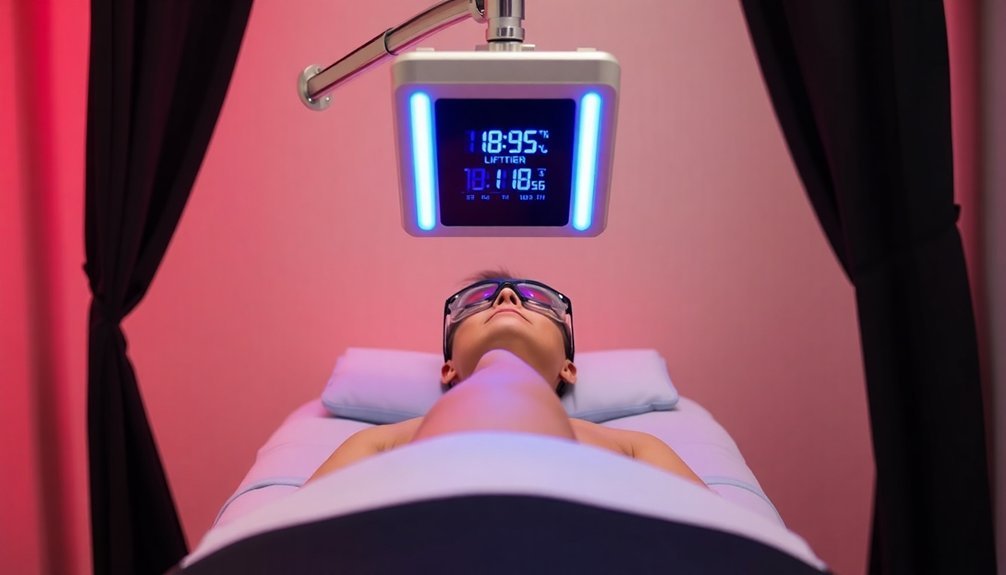
Safety should be your top priority when using NIR therapy to improve blood flow. Before starting treatment, make sure you're in a well-ventilated area and position yourself 6-12 inches from the device. Clean and dry your skin thoroughly, avoiding any lotions or oils that might interfere with the therapy's effectiveness.
| Safety Consideration | What to Do | What to Avoid |
|---|---|---|
| Eye Protection | Wear protective eyewear | Don't stare at light source |
| Skin Monitoring | Check for reactions | Don't use over suspicious growths |
| Treatment Area | Stay 6-12" from device | Don't treat sensitive areas |
During your session, don't use NIR therapy if you're pregnant, breastfeeding, or taking medications that cause light sensitivity. If you're using steroids or anti-inflammatory drugs, you'll need to discontinue NIR treatments. Always perform a light sensitivity test before your first full session, and monitor your skin for any adverse reactions throughout the treatment.
If you experience discomfort or excessive heat, adjust the device's intensity or distance. Remember, you shouldn't share your NIR device with others for hygiene reasons. If you have any medical conditions or uncertainties, consult your healthcare provider before starting NIR therapy.
Best NIR Devices
Leading-edge NIR devices offer varying features and capabilities to match different treatment needs. When you're looking for full-body treatment, the OvationULT stands out with its impressive 28,443 diodes and zero-gravity design, supporting users up to 450 pounds.
For targeted therapy, the ApolloARC and ApolloGLOW provide high irradiance at 191mw/cm² with efficient 12-minute treatment sessions.
If portability is your priority, you'll find excellent options in today's market. The DeepWavePRO's compact size makes it perfect for on-the-go treatments, while the Hooga HGPRO4500 offers a balance between mobility and full-body coverage.
Here are the top features to evaluate when choosing an NIR device:
- Irradiance levels – Higher values like 200mW/cm² provide deeper tissue penetration
- Wavelength combinations – Dual wavelengths (635nm/850nm) offer broader therapeutic benefits
- Treatment area coverage – More diodes generally mean larger treatment areas and better coverage
The choice ultimately depends on your specific needs – whether you're seeking full-body therapy, targeted treatment, or a portable solution. Each device offers unique advantages in regard to power, coverage, and convenience.
Treatment Areas For Blood Flow
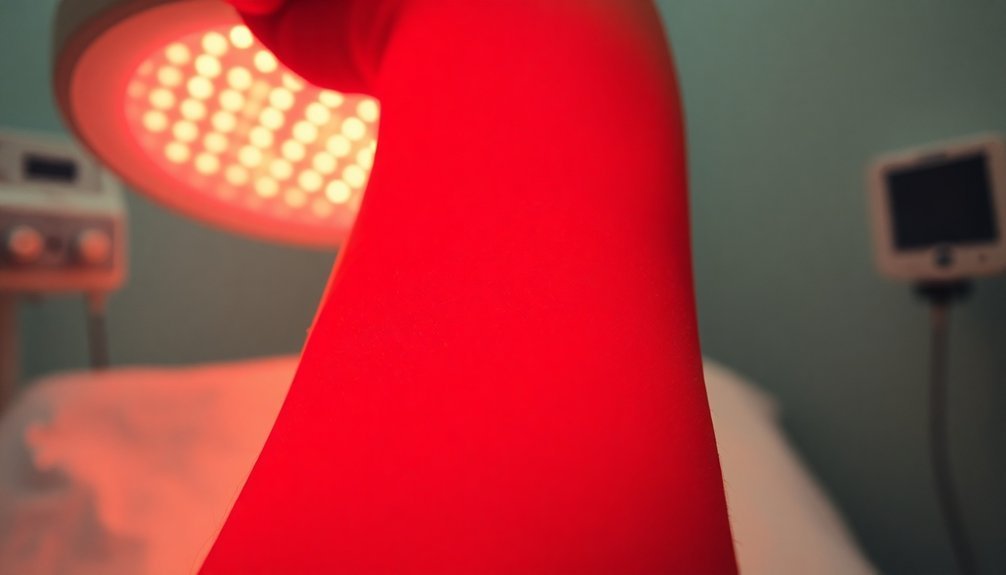
Once you've selected the right NIR device, understanding where to apply the therapy for ideal blood flow becomes your next step.
You'll find that NIR therapy effectively treats multiple areas where blood flow issues commonly occur, from surface-level problems to deeper tissue concerns.
For musculoskeletal issues, you can target areas experiencing chronic pain, particularly in your neck and joints.
If you're dealing with diabetic neuropathy or chemotherapy-induced nerve problems, you'll want to focus the therapy on affected limbs to enhance oxygen delivery and promote healing.
You can also use NIR therapy for internal conditions. It's particularly effective for treating hemorrhoids and promoting wound healing.
If you're experiencing brain-related issues, transcranial NIR therapy can help improve your cerebral blood flow.
For those with restless leg syndrome, directing the therapy to your legs can enhance local circulation and reduce symptoms.
The therapy works by stimulating nitric oxide release, which dilates your blood vessels and improves circulation.
You'll notice enhanced tissue repair and reduced inflammation in treated areas, making it an effective solution for various circulatory concerns.
Expected Treatment Results
Many patients see noticeable improvements in blood flow within the first few weeks of NIR therapy treatment. You'll likely experience reduced inflammation and pain as the therapy stimulates nitric oxide production, leading to better vasodilation and enhanced circulation throughout your body.
This improvement often translates to faster healing times and better overall recovery, especially if you're dealing with injuries or chronic conditions.
With consistent NIR therapy sessions, you can expect several key benefits:
- Improved cardiovascular health with reduced blood pressure and enhanced circulation, which you'll notice through better energy levels and reduced fatigue
- Enhanced wound healing and skin health due to increased blood flow and reduced inflammation, resulting in faster recovery from injuries
- Better muscle recovery and reduced joint pain, particularly beneficial if you're dealing with conditions like rheumatoid arthritis or recovering from intense physical activity
The therapy's effects on your microcirculation can lead to long-lasting improvements in areas with previously poor blood flow. You'll likely notice reduced swelling in problem areas, particularly if you're dealing with conditions like lymphedema or varicose veins, as the therapy helps improve lymphatic drainage and overall circulation.
Frequently Asked Questions
Can NIR Therapy Help With Cold Hands and Feet Syndrome?
Yes, NIR therapy can help your cold hands and feet by improving blood circulation, boosting nitric oxide production, and widening blood vessels. You'll experience better blood flow and reduced symptoms with regular treatment.
How Long Does Increased Blood Flow Last After Each NIR Session?
You'll typically experience increased blood flow for several hours after a 20-minute NIR session. The exact duration varies based on your condition, treatment intensity, and individual response to the therapy.
Does NIR Therapy Work Differently for Elderly Versus Younger Patients?
While you'll see similar circulation benefits across age groups, elderly patients often experience stronger cardiovascular improvements, while younger patients typically notice faster athletic recovery and enhanced skin health from NIR therapy.
Can NIR Therapy Improve Blood Clotting Disorders?
Yes, NIR therapy can help with your blood clotting disorders through targeted treatment. You'll benefit from its ability to detect clots, break them down using heat, and improve circulation while reducing inflammation.
Will NIR Therapy Affect Blood Pressure Medication Effectiveness?
NIR therapy can affect your blood pressure medication's effectiveness since it improves blood flow and nitric oxide production. You'll need to work with your doctor to monitor and potentially adjust your medication dosage.
In Summary
You'll find NIR light therapy to be a promising, non-invasive treatment for improving your circulation and blood flow. By following proper protocols and using quality devices, you can experience reduced inflammation, faster healing, and better overall vascular health. Start with short sessions, monitor your progress, and consult your healthcare provider to confirm you're getting the most benefit from this innovative therapy.





Leave a Reply